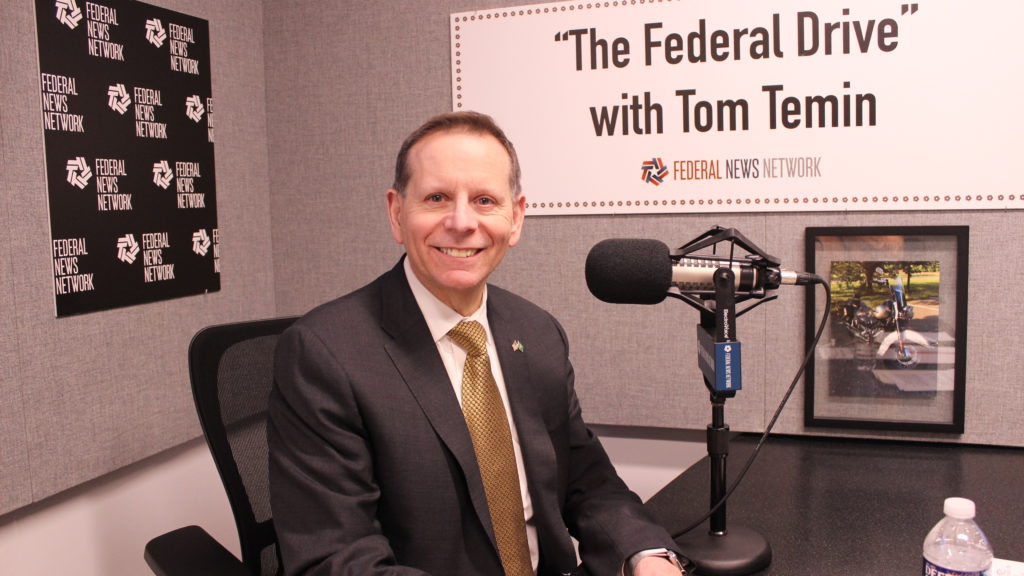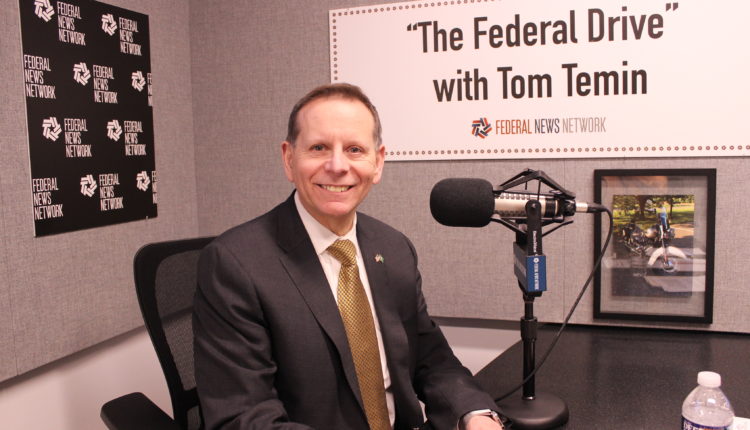
Best listening experience is on Chrome, Firefox or Safari. Subscribe to Federal Drive’s daily audio interviews on Apple Podcasts or PodcastOne.
The relationship between the military veteran and the Department of Veterans Affairs can literally last a lifetime. It can also be fraught with disputed decisions and long backlogs. After spending three years as Undersecretary for Veterans Benefits during the Trump administration, Paul Lawrence has learned a few lessons. He joined the Federal Drive with Tom Temin earlier in studio with what they were.
Tom Temin: And Paul, the idea of this lifelong relationship is real, isn’t it? I mean, veterans are beneficiaries in one way or another for life.
Paul Lawrence: Right, actually, in fact, is interesting, Tom, because if you think about it, veterans, when they’re in the military are demonstrating the responsibilities of citizenship protecting us all. And then they get rights afterwards. And this comes from Congress in terms of the benefits. And the deal is or the attempt is to connect veterans to VA right away, and there was a new program put in place called Solid Start to try to talk to veterans and remind them that VA is there for them. And then we administer the benefits – that’s what I oversaw – that they’ve earned, that’s supposed to help them accelerate their pursuit of the American dream. The GI Bill education benefit gets them an education, free college and things like that, get them a great job; the Home Loan Guarantee, buy a home with no money down while your friends are trying to save; as well as things like disability compensation if you’ve been injured or disabled in service. So it’s really well thought out. But as you’re leading points out, there are some challenges in administering benefits. And veterans are not a shy group. So they reminded us of it all the time when I was in office.
Tom Temin: The idea of backlogs is particularly troublesome. It’s something that plagues so many federal programs. And if you’re waiting for a disability decision, and you are actually disabled, then that can be real hardship. And so, over the years, there have been various attempts to try to get through this. What did you find?
Paul Lawrence: Well, one of the things I was most proud of as that when during I was there, the backlog – those are claims that are waiting more than 125 days to be adjudicated. And so you see these numbers, 500,000 – 600,000 – we got it to the lowest level ever, ever, ever in VBA history of just under 65,000 claims. And that was really pretty good. In fact, at one point, we were worried about running out of work, but as the number of claims increase, and if the administration issues presumptives, “Hey, if you’ve been there and have these conditions?” claims increase. You’re right, it’s a steady ebb and flow. And nothing frustrates veterans more than working in the private sector, or seeing the private sector and seeing how fast things are happening, then turning to the VA and seeing things are going slow. So that’s a real important performance metric but one I paid a lot of attention to. It involved, literally hands-on management, working with the team and a right number employees, but also techniques, technology and the like. But really managing it – isn’t just a passive thing that happens to veterans, and it pains me when the backlog grows, because that means veterans are suffering. Betting benefits from VBA enables you now to go to the VHA and get medical care. It really sets in motion, a lot of things. So it’s very, very important. And quite frankly, the final sort of point is, if your first experience out of the military is with a good processing of your claim, your perception of VA is very, very positive. And I think that was important, too.
Tom Temin: Sure. And I wanted to switch gears and ask about the issue of just Federal Public Program Management from the standpoint of the fact that in the VA, the benefits piece, there is only one political appointee, and that is the undersecretary the job you had. So to do anything, you really need to get the bureaucracy on your side.
Paul Lawrence: That’s right. I was somewhat surprised. I didn’t really appreciate that until I got there. But to be honest with you, it was very much a run the trains operation. And so I was very lucky and fortunate that there was a great set of careers there who really did want to focus on the mission of serving veterans. If I recall, right, 55% of the VA employees are war veterans. So it was very much veterans helping veterans. And it was easy to motivate them to want to improve service. And quite frankly, the better they got, the easier it was to talk about how good benefits were being delivered, and the better they wanted to be. So it was good to see the transformation from an organization that was always seen as behind or struggling to one that really was doing great work for our veterans. By the time we all left.
Tom Temin: We’re speaking with Paul Lawrence, he’s former VA Undersecretary for Benefits. And how well do you think the military defense department prepares about-to-be veterans for veteran life, including informing them of what they need to do next, with respect to the Veterans Affairs Department?
Paul Lawrence: Well, they try real hard to do it. I think there’s a program called Transition Assistance or TAP – Transition Assistance Program – that’s supposed to be offered to service members before they fulfill their service obligation leave. The challenge, of course, is the military thinks about retention. And so there’s just not a lot of personal incentives to get our veterans there. So they do make it available. I wish attendance were higher. I wish the course were longer but it’s structured by law. So they do and it’s very much different than back in the day when I left. “Here’s your DD-214. See you later, bye.” I sent resumes to [companies] that I found in a phone book to try to find a new job. So it’s very, very different. And the availability of private sector organizations, nonprofit, social media organizations, to help veterans become employed, once they become [veterans] is much, much greater.
Tom Temin: I remember phone books, they used to have pages that were yellow in the back, and they’re –
Paul Lawrence: There you go.
Tom Temin: And of course, your last year in office was the first year of the pandemic. And we know that had profound benefits on the health side of VA. Did that really affect the benefit side in any way? And how did you have to operationalize around that?
Paul Lawrence: Sure a lot of things had been done in person, veterans would walk into the VBA offices around the country, you couldn’t do that anymore. Education was changed tremendously. You used to go to a campus and get a benefit based on your attendance at campus. But if you took your classes online, you got much less of this housing allowance. So Congress changed the law. So I had a scurry to get that figured out as to who was due what a lot of the in-person things change. So as a result, I started doing telephone town halls with veterans to get them information and answer their questions and help them with that. So one of the big things was my personal involvement in terms of these telephone town halls. I did 110 in 2020, reached about 5.7 million veterans and I took questions during it. It wasn’t one-way conversation. I had a team listening in to help veterans. So I estimate taking 15 questions on these hundreds. I talked to personally 1,500 or more veterans. And so I really learned a lot about their experience. And it really helped me develop a better understanding of what veterans want from the VA, from VBA. And also just how to talk to our team about it. They would brief me on things and I would be able to say, well, when I talk to veterans on the phone, they’re telling me this process isn’t working exactly as we describe it, can we look at it better? So it was valuable for a lot of reasons. But it was a very hard year.
Tom Temin: So the challenge, then is making sure that the process matches what you and the staff, as veterans know, that veterans care about, and desire. But sometimes the processes don’t match up.
Paul Lawrence: The processes don’t match up, and also our understanding of what is expected. So I went into their job thinking, hey, what really matters is you get the benefits process quickly. But what I also heard was how veterans struggle, and how complex the system is. And so how it was just a very hard experience. So I thought about, the real challenge is to make it a better experience, and really appreciate what the veterans are going through. Yes, they want it fast. But it shouldn’t take lawyers or people just so frustrated at the forums and the like. So the real challenge is making it better. Because promising veterans benefits, but not being able to deliver really as a false promise.
Tom Temin: And there are other ways to get information. I mean, talking to veterans and being able to have an exchange with 1,500 of them is good information. But are there also metrics on the data sense? Because now the trend in government is data-driven decision making and program design. What are the most important metrics other than how big the backlog is?
Paul Lawrence: Certainly, well, basically, there was a lot of metrics. VBA was really ahead of the curve and sort of their understanding of information. And actually, Tom, the challenge was just the opposite. What are the right few metrics to get everyone to pay attention to? So I probably spent the first six months figuring that out. And then I think you may recall, during my time in office, every three months, I held a quarterly broadcast of essentially VBA’s performance pointing out by the different business lines, the key metrics, how fast things had been done, how many were waiting, what the quality of it was in some new programs. So I was very proud of being transparent, identifying those, and quite frankly, talking about how well we were doing, and even to the point where things weren’t going well, what was going to be done to fix it so that the next time came back in three months could talk about it. So it was actually, the problem of too much data, narrowing it down and finding the right things. And again, veterans would tell you, this is what I expect from this service. I expect my pension delivered fast. I expect you to process all this paperwork that you asked for me – quickly and accurately.
Tom Temin: And often in public life much has made variations between generations. In the Veterans Affairs Department, you’ve got, still serving a few Korean War veterans or well, actually, some World War II people are still alive, a few. A lot of Vietnam, a lot of subsequent to Vietnam, many Iraq and Afghanistan – that’s the major cohort right now coming in. But is there really that much generational difference between what it is people need and want from VA, whether it’s Vietnam era or Afghanistan?
Paul Lawrence: Not broadly, they all expect a high level of service and part of what my view of the world is, it’s reasonable to think that veterans should get world class service from the VA. That ought to be of the minimum understanding. So they all deserve a great deal of service from VA in response to their service. But there are some subtleties, right? We’re smarter about things that took place, our understanding of Environmental Sciences tells us about certain benefits, our ability to handle certain things is different. But broadly, the GI bill goes back to World War II. And that’s still one of the most used benefits, right? So it gets improved in the light. But no veterans expect the same thing. And really the challenge is to figure out how to deliver it. They receive the information differently. As you point out, veterans now want everything online. But our more senior veterans don’t do that. In fact, I was surprised with the tele-town halls are referred to earlier how important phone calls were to folks. And I don’t mean, just like in the hills of our country, but just outside the major cities where I forget, internet connectivity isn’t as strong as maybe we think it should be. So it was really the subtle differences and understanding that but you’re right, at any one point, you’re serving a wide range of customers. So it’s different in the private sector where you could segment and decide which ones are easiest to deal with. So no, you’ve got to deal with them all.
Tom Temin: Paul Lawrence is former VA Undersecretary for Benefits and author of “Transforming Service to Veterans,” a new book. Thanks for joining me.
Paul Lawrence: No, thank you for having me.


Comments are closed.